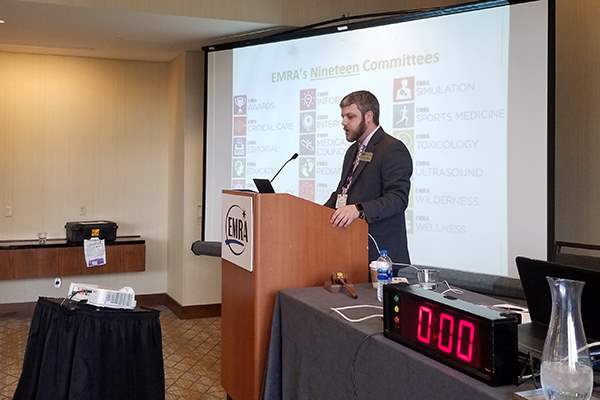Advocating for Early Emergency Medicine Clinical Exposure in Medical School
Kristina M. Pagano, MS-III, FIU Herbert Wertheim College of Medicine
EMRA MSC Southeast Regional Coordinator 2024-2025
Samantha J. Jacobson, OMS-III, Edward Via College of Osteopathic Medicine- Louisiana EMRA MSC Southcentral Regional Representative 2024-2025
Babayode Bakare, MS-III, Morehouse School of Medicine
EMRA MSC Southeast Regional Representative I 2024-2025
Cristina Sanchez, MS-III, Florida State University College of Medicine
EMRA MSC Southeast Regional Representative II 2024-2025
Historically, Emergency Medicine (EM) has been a specialty excluded from the standard third-year medical school curriculum. However, incorporating EM as a clerkship adds significant value to the clinical experience of medical student education, irrespective of the student’s chosen specialty. The EM clerkship teaches medical students how to quickly yet accurately assess and treat critically ill patients, work collectively within a team, and effectively provide patient care in a high-stress environment. Despite the immense value they bring, the EM third year clerkships are rare and their scarcity poses significant challenges for medical students.1 As indicated by the LCME Annual Medical School Questionnaire from 2019-2020,2 67/153 (41%) medical schools in the United States participate in third-year Emergency Medicine clerkship exposure. Although the literature shows that medical students who complete an EM clerkship show significant growth in their knowledge of acute care settings, disease management, and procedural skills,3 the integration of a third year EM elective and mandatory rotations in US medical schools remains low. The existing state of EM within the third year curriculum limits the education of medical students while also creating a significant barrier, limiting students’ exposure to EM as a potential specialty of choice.
Today, medical students have varying exposure to the field of emergency medicine during their academic career. The variation in exposure has influenced the match rate in emergency medicine residency programs. Notably, the 2023 match cycle had a match fill rate of 81.6% (with 555 unfilled PGY-1 EM positions) compared to the 2022 match rate of 93% (with 219 unfilled PGY-1 EM positions)4. The current supply/demand mismatch has been postulated to be due to a variety of factors including the increase in new residency programs, the influence of the media, COVID-19 pandemic, and guidance of physician mentors, all of which collectively contribute to the students’ perceptions of the EM specialty as a whole. The current supply/demand mismatch is thought to have a profound impact on not only the specialty of EM but also on the population the field serves.4 Because of this, it is imperative that medical students are given adequate exposure, allowing them to consider the field and make informed decisions about their medical career paths.
It has been predicted that by 2030, there will be an increased need for EM physicians due to the increase in the geriatric population.5 Due to the increased demands for EM physicians it is imperative to increase the EM clerkship exposure throughout US medical schools. Recently, EMRA released an updated Resolution F’23-04 amending EMRA Policy Section VI-V titled “Increasing Emergency Medicine Clerkship Opportunities for Medical Students” (EMRA, 2023), with which EMRA took a stance in recognizing and supporting an increase in elective and mandatory EM clerkships prior to the fourth year of medical school.6 The resolution aimed at acknowledging the problem of EM clerkship opportunities for students and implications for the future of emergency medicine, where increasing early exposure could potentially increase the students applying into emergency medicine.
An important point to consider is the unique nature of the EM residency application process, including the use of the standardized letter of evaluation (SLOE). The SLOE was developed by the Council of Emergency Medicine Program Directors (CORD) task force in 1997 with the purpose of creating a standardized, concise, and discriminating letter of recommendation and has arguably become one of the most important components of a student’s application when program directors are evaluating candidates for residency.7 Today, EM residency programs require a minimum of one SLOE, but two are preferred by many programs.8 It is recommended that students applying into emergency medicine should complete a total of two EM rotations prior to applying.9 Students with later exposure to the specialty to EM may struggle to obtain the two SLOEs compared to students with earlier exposure.
What can we do as students?
As passionate medical students who care about the field of emergency medicine and the people who comprise it, we need to advocate for an earlier introduction to the specialty within our medical education. With over half of the medical schools in the United States not providing emergency medicine clerkship experience until the fourth year, many students do not have the opportunity to experience the challenging, dynamic, and cohesive atmosphere and unique work being done in the emergency department each day. In the current state, students can have their core EM rotations after their peers have had the opportunity to apply to audition/away rotations, leaving them at a disadvantage when deciding to switch into emergency medicine, especially when considering the requirement of receiving SLOEs. Many medical students who decide on emergency medicine early in their medical school career have had early exposure, whether from previous work as a scribe or first-responder. However, those lacking this exposure are left to form opinions about a specialty they have yet to experience. Let’s change this.
How can medical students advocate for early emergency medicine clinical exposure at their medical schools? It begins with raising awareness among fellow medical students. Collaborate with groups such as your medical school’s Emergency Medicine Interest Group (EMIG) or other emergency medicine groups to discuss this issue and bring these concerns to your Dean. Use EMRA’s updated resolution as a reference and use it to initiate a conversation amongst your classmates and your school’s leadership. Bring your concerns to your school’s Town Hall and advocate the principles outlined in EMRA’s resolution.
If you are part of an EMIG, work with your school’s faculty to organize student shadowing opportunities in the hospital. These shadowing opportunities allow students to not only experience, firsthand, what it is like in the emergency department but also allows students to connect with the staff and network with emergency department physicians. Additionally, this can facilitate early mentorship that allows for the success of students pursuing careers in emergency medicine.
If you have successfully advocated for early emergency medicine exposure at your medical school, EMRA would love to hear about it! Write an article about your experiences, what was effective, and the challenges you faced. EMRA and other medical students would love to hear another student’s perspective on this ongoing dialogue and would like to celebrate the victories students’ have had!
References
1 Tews MC, Hamilton GC. Integrating emergency medicine principles and experience throughout the medical school curriculum: why and how. Acad Emerg Med 2011;18:1072–80.
2 Clerkship Week requirements by curriculum year. AAMC. Accessed August 26, 2023. https://www.aamc.org/data-reports/curriculum-reports/data/clerkship-week-requirements-curriculum-year.
3 Avegno JL, Murphy-Lavoie H, Lofaso DP, Moreno-Walton L. Medical students’ perceptions of an emergency medicine clerkship: An analysis of self-assessment surveys. International Journal of Emergency Medicine. 2012;5(1). doi:10.1186/1865-1380-5-25
4 Lewis M, Williams K, Timpe J, Corbo S, Wilbanks M, Hayes AK. The 2022 and 2023 Emergency Medicine Residency Match: A Cautionary Tale. Cureus. 2023 May 5;15(5):e38601. doi: 10.7759/cureus.38601. PMID: 37284385; PMCID: PMC10239656.
5 Koski-Vacirca R, VanderVinne N, Burmeister B. Emergency medicine advocacy handbook, 6th ed. , EMRA. 2019. Accessed August 26, 2023. https://www.emra.org/books/advocacy-handbook/advhbook/.
6 Pagano K, Bronstein D, Gordon D, Messner B, Lumbreras T, Jacobson K. Resolution F'23-04 : Amending EMRA Policy Section VI-V: Increasing Emergency Medicine Clerkship Opportunities for Medical Students. 2023
7 Jackson JS, Bond M, Love JN, Hegarty C. Emergency Medicine Standardized Letter of Evaluation (SLOE): Findings From the New Electronic SLOE Format. J Grad Med Educ. 2019 Apr;11(2):182-186. doi: 10.4300/JGME-D-18-00344.1. PMID: 31024650; PMCID: PMC6476101.
8 King K, Kass D. What Do They Want from Us? A Survey of EM Program Directors on EM Application Criteria. West J Emerg Med. 2017;18(1):126-128. doi:10.5811/westjem.2016.10.31496
9 Dubosh N, Murano T, Cai A, Sun WW. Consensus Statement for the Emergency Medicine 2022-2023 Residency Application Cycle Regarding Emergency Medicine Away Rotations. https://www.emra.org/be-involved/be-an-advocate/working-for-you/statement-for-residency-application-cycle-em-away-rotations
Related Content







